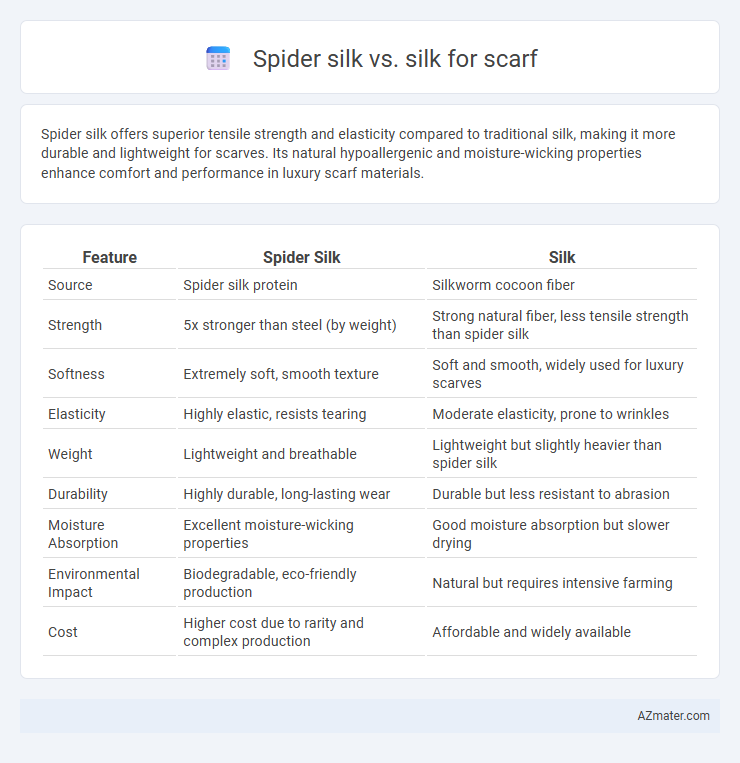Spider silk offers superior tensile strength and elasticity compared to traditional silk, making it more durable and lightweight for scarves. Its natural hypoallergenic and moisture-wicking properties enhance comfort and performance in luxury scarf materials.
Table of Comparison
| Feature | Spider Silk | Silk |
|---|---|---|
| Source | Spider silk protein | Silkworm cocoon fiber |
| Strength | 5x stronger than steel (by weight) | Strong natural fiber, less tensile strength than spider silk |
| Softness | Extremely soft, smooth texture | Soft and smooth, widely used for luxury scarves |
| Elasticity | Highly elastic, resists tearing | Moderate elasticity, prone to wrinkles |
| Weight | Lightweight and breathable | Lightweight but slightly heavier than spider silk |
| Durability | Highly durable, long-lasting wear | Durable but less resistant to abrasion |
| Moisture Absorption | Excellent moisture-wicking properties | Good moisture absorption but slower drying |
| Environmental Impact | Biodegradable, eco-friendly production | Natural but requires intensive farming |
| Cost | Higher cost due to rarity and complex production | Affordable and widely available |
Introduction to Spider Silk and Traditional Silk
Spider silk, produced by orb-weaving spiders, is a natural protein fiber renowned for its exceptional strength, elasticity, and lightweight properties, making it an innovative material for luxury scarves. Traditional silk, derived from the cocoons of the silkworm Bombyx mori, offers a smooth texture and lustrous appearance valued in fashion for centuries. Both fibers possess unique molecular structures: spider silk's beta-sheet nanocrystals provide superior tensile strength, while silkworm silk's fibroin beta turns contribute to its characteristic softness and sheen.
Origins: Where Spider Silk and Silk Come From
Spider silk is a natural protein fiber produced by spiders from specialized glands, with properties tailored for web construction and prey capture. Silk, traditionally used in scarves, originates from the cocoons of silkworms, primarily the Bombyx mori species, cultivated in sericulture practices. Both fibers have distinct biological sources, with spider silk emerging from arachnids and silk from lepidopteran larvae.
Production Methods: Spiders vs. Silkworms
Spider silk is produced by spiders through specialized spinnerets that extrude protein-based fibers, a process that happens naturally in the wild and is difficult to replicate on an industrial scale. In contrast, silk for scarves primarily comes from silkworms, which spin cocoons that are harvested and then boiled to extract continuous silk threads, a method perfected through centuries of sericulture. The complexity of farming spiders as opposed to silkworms makes spider silk rarer and more expensive, while silkworm silk benefits from efficient mass production technologies.
Texture and Feel: Comparing the Fabrics
Spider silk scarves offer an unparalleled combination of lightweight softness and remarkable tensile strength, resulting in a fabric that feels exceptionally smooth and resilient against the skin. Traditional silk scarves, derived from silkworm fibers, boast a luxurious, glossy texture with a natural sheen and moderate breathability, providing a warm yet airy feel. While spider silk is often more durable and hypoallergenic, silkworm silk remains favored for its classic elegance and supple touch in high-end scarf designs.
Strength and Durability: Which Is More Resilient?
Spider silk exhibits remarkable tensile strength and elasticity, often surpassing traditional silk in durability and resistance to wear. Unlike silk from silkworms, spider silk fibers possess a unique protein structure that absorbs more energy before breaking, making them highly resilient under stress. This superior strength and flexibility make spider silk an exceptional material for scarves that require long-lasting performance.
Breathability and Comfort for Scarf Wearers
Spider silk exhibits superior breathability compared to traditional silk due to its microstructure, allowing better moisture wicking and airflow, which enhances comfort for scarf wearers. Its natural elasticity and lightweight fibers provide a soft, smooth texture that prevents irritation and maintains comfort throughout extended wear. Traditional silk, while smooth and luxurious, often retains heat and moisture, making spider silk a more breathable and comfortable choice for scarves.
Appearance: Shine, Luster, and Color Differences
Spider silk exhibits a natural, subtle shine with a unique, iridescent luster that changes slightly under different lighting conditions, creating a dynamic visual appeal. Traditional silk, derived from silkworms, offers a smooth, consistent glossy finish with vibrant, rich color saturation that enhances the fabric's elegance. The color palette of spider silk tends to be more muted and earthy, while silk provides a wider range of vivid hues due to advanced dye absorption.
Sustainability and Environmental Impact
Spider silk offers superior sustainability compared to traditional silk due to its biodegradable properties and minimal resource consumption during production, requiring no water-intensive farming or harmful chemicals. In contrast, conventional silk production from silkworms involves mulberry cultivation and significant land use, impacting biodiversity and water resources. Choosing spider silk scarves supports environmentally conscious fashion by reducing carbon footprint and promoting renewable biomaterials.
Cost and Accessibility for Consumers
Spider silk scarves are significantly more expensive and less accessible due to the complex and labor-intensive process of harvesting spider silk, limiting production to niche markets. Conventional silk scarves, made from silkworm cocoons, offer a more affordable and widely available option for consumers due to established manufacturing infrastructure and higher yield. Cost differences often exceed hundreds of dollars per scarf, making traditional silk the preferred choice for most buyers seeking balance between luxury and accessibility.
Which Silk Makes the Best Scarf?
Spider silk offers exceptional strength and elasticity combined with a lightweight texture, making it highly durable and comfortable for scarves. Traditional silk, derived from silkworms like Bombyx mori, is renowned for its smooth, lustrous finish and excellent breathability, making it a popular choice for luxurious scarves. While spider silk is rare and costly due to production challenges, silkworm silk balances affordability, softness, and sheen, often making it the preferred material for high-quality scarves.

Infographic: Spider silk vs Silk for Scarf
 azmater.com
azmater.com